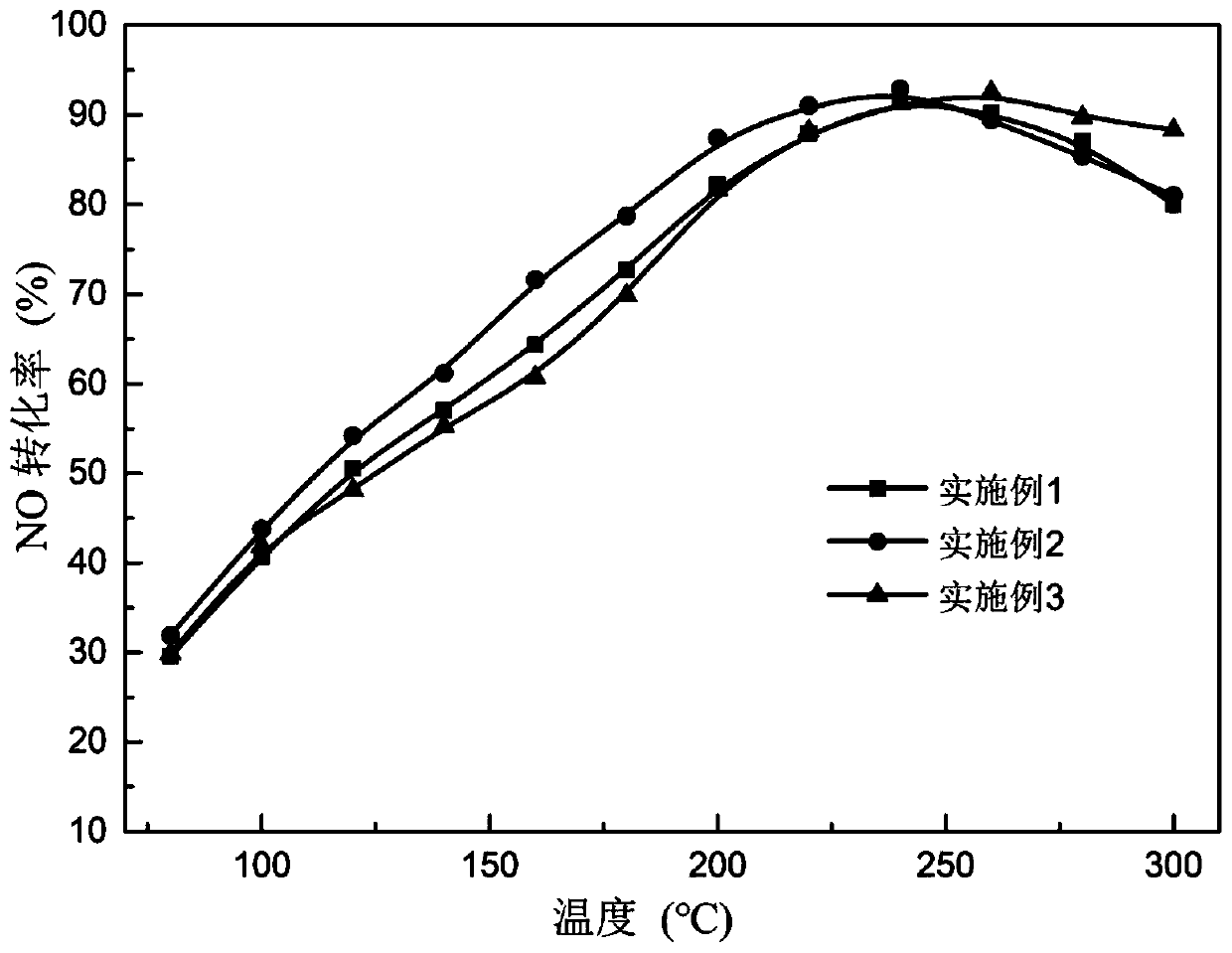Low-temperature SCR denitration catalyst based on kaoline and preparation method of catalyst
A denitration catalyst and kaolin technology, applied in the field of denitration catalysts, can solve the problems of high cost of titanium dioxide, cumbersome co-precipitation process, increase catalyst preparation cost, etc., and achieve the effects of good application prospect, strong denitration ability and wide active temperature window.
- Summary
- Abstract
- Description
- Claims
- Application Information
AI Technical Summary
Problems solved by technology
Method used
Image
Examples
preparation example Construction
[0028] Such as figure 1 Shown, a kind of preparation method of above-mentioned low-temperature SCR denitration catalyst, this method comprises the following steps:
[0029] (a) select manganese nitrate and cerium nitrate as raw materials, mix the two and dissolve them in deionized water to obtain an impregnation solution;
[0030] (b) adding a certain quality of kaolin to the impregnation solution, stirring at room temperature to obtain a suspension;
[0031] (c) Magnetically stirring the suspension until it becomes viscous to obtain a mixture, which is dried and calcined to obtain the desired catalyst.
[0032] Preferably, in step (b), the stirring time at room temperature is 4h-6h, so that the active components can be better dispersed in the impregnation solution.
[0033] Preferably, in step (c), the temperature of the magnetic stirring is preferably 40°C to 80°C, and the stirring time is 3h to 6h, so that the active component is further dispersed in the impregnation solu...
Embodiment 1
[0037] A. Accurately weigh 0.01mol Ce(NO 3 ) 3 ·6H 2 O and 0.05mol Mn(NO 3 ) 2 , dissolved in 80ml deionized water to form a solution, and magnetically stirred for 30min to mix well.
[0038] B. Accurately weigh 0.05 mol of kaolin and add it to the above-prepared solution. During this process, it is necessary to add kaolin slowly while vigorously stirring the solution magnetically, and magnetically stir for 6 hours at room temperature.
[0039] C. Continue to magnetically stir the white suspension obtained above at 80° C. for 3 h until the mixture becomes viscous.
[0040] D. Keep the above product at 80°C for 15h in a blast drying oven, take it out and bake it in a temperature-programmed muffle furnace at 500°C for 3h.
[0041] The catalyst activity test uses a micro-catalytic device to test the catalyst. The flue gas components used in the experiment are:
[0042] NOx concentration in flue gas is 800ppm, NOx / NH 3 = 1:1;
[0043] o 2 The concentration is 5%;
[0044...
Embodiment 2
[0048] A. Accurately weigh 0.01mol Ce(NO 3 ) 3 ·6H 2 O and 0.08mol Mn(NO 3 ) 2 , dissolved in 80ml deionized water to form a solution, and magnetically stirred for 30min to mix well.
[0049] B. Accurately weigh 0.08 mol of kaolin and add it to the above-prepared solution. During this process, it is necessary to add kaolin slowly while vigorously stirring the solution magnetically, and magnetically stir for 4 hours at room temperature.
[0050] C. Continue to magnetically stir the white suspension obtained above at 40° C. for 6 h until the mixture becomes viscous.
[0051] D. Keep the above product at 80°C for 15h in a blast drying oven, take it out and bake it in a temperature-programmed muffle furnace at 450°C for 4h.
[0052] The catalyst activity test uses a micro-catalytic device to test the catalyst. The flue gas components used in the experiment are:
[0053] NOx concentration in flue gas is 800ppm, NOx / NH 3 = 1:1;
[0054] o 2 The concentration is 5%;
[0055...
PUM
| Property | Measurement | Unit |
|---|---|---|
| denitrification rate | aaaaa | aaaaa |
| denitrification rate | aaaaa | aaaaa |
Abstract
Description
Claims
Application Information
 Login to View More
Login to View More - R&D
- Intellectual Property
- Life Sciences
- Materials
- Tech Scout
- Unparalleled Data Quality
- Higher Quality Content
- 60% Fewer Hallucinations
Browse by: Latest US Patents, China's latest patents, Technical Efficacy Thesaurus, Application Domain, Technology Topic, Popular Technical Reports.
© 2025 PatSnap. All rights reserved.Legal|Privacy policy|Modern Slavery Act Transparency Statement|Sitemap|About US| Contact US: help@patsnap.com


